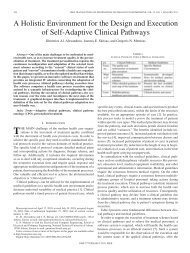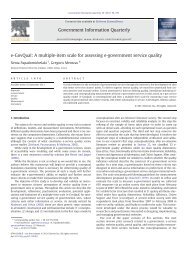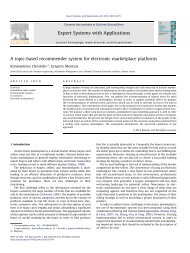Ontology-Based Competency Management for Corporate E-Learning
Ontology-Based Competency Management for Corporate E-Learning
Ontology-Based Competency Management for Corporate E-Learning
You also want an ePaper? Increase the reach of your titles
YUMPU automatically turns print PDFs into web optimized ePapers that Google loves.
<strong>Ontology</strong>-<strong>Based</strong> <strong>Competency</strong> <strong>Management</strong> <strong>for</strong> <strong>Corporate</strong> E-<strong>Learning</strong> 315<br />
Research work is also conducted in the usage of ontologies in learning objects in order to<br />
facilitate the discovery and reuse of learning objects stored in local and global repositories<br />
(e.g., Sicilia, Garcia, Diaz, & Aedo, 2002; Urban & Barriocanal, 2003). A learning object<br />
is defined as “any entity, digital or non-digital, that may be used <strong>for</strong> learning, education<br />
or training” (IEEE <strong>Learning</strong> Technology Standards Committee, 2001). Initiatives such as<br />
the IEEE learning object metadata (LOM), Dublin Core and IMS Global Consortium, are<br />
developing standards, specifications and reference models <strong>for</strong> learning objects in order to<br />
facilitate the online retrieval and reusability of the latter. In the future, developments of the<br />
discussed system lies in the automatic discovery of learning objects from global repositories<br />
and their mapping with competency gap reports in order to facilitate the user to access both<br />
local and global repositories of learning objects.<br />
Moreover, the use of ontologies in e-learning applications has been theoretically researched,<br />
<strong>for</strong> example, with the architectural proposal of a prototype system <strong>for</strong> e-learning using<br />
ontologies (Schmidt & Winterhalter, 2004; Stojanovic, Steffen, & Studer, 2001). Some<br />
research ef<strong>for</strong>ts in integrating competency ontologies with e-learning have taken place in<br />
theoretical background (Woelk, 2002) and have been partially implemented (Hirata, Ikeda,<br />
& Mizoguchi, 2001).<br />
Additionally, many learning management systems integrate competency management features<br />
without ontological support. For a detailed analysis of the main competency management<br />
features included in some popular learning management systems (LMS), one can refer to<br />
Draganidis and Mentzas (in press).<br />
Evidently, there is a gap in the integration of ontology-based, competency-driven e-learning<br />
systems. Our system’s target is to develop and deploy an ontology-based competency<br />
management system, which will provide the possibility <strong>for</strong> further enhancements, such as<br />
succession planning and training analysis, always using the developed ontology as a reference.<br />
Moreover, through the use of Web services the system can be integrated with other<br />
human resource management or e-learning systems.<br />
System Architecture and Design<br />
Our research ef<strong>for</strong>ts focus on developing a prototype ontology-based system, which will<br />
integrate competency management with e-learning and other human resource functions,<br />
such as succession and career planning, training needs analysis and organizational planning;<br />
Figure 1 outlines the conceptual design of our system.<br />
The system is based on ontological structures: the competency ontology and the learning<br />
objects ontology. The competency ontology describes the competency model of the organization,<br />
as this is defined by the human resources director. Each competency is composed<br />
of four proficiency levels, which correspond to one or more indicating behaviors.<br />
Table 2 analyzes the four behaviors that can be observed regarding the competency “team<br />
leadership.” Of course, the definition of these behaviors is different according to the needs<br />
of the organization to which the competency model refers to, and the following descriptions<br />
are used only as random examples.<br />
Copyright © 2007, Idea Group Inc. Copying or distributing in print or electronic <strong>for</strong>ms without written permission<br />
of Idea Group Inc. is prohibited.





